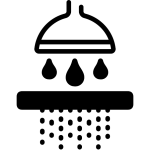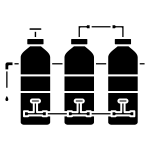As the temperature begins to drop, homeowners face a serious yet often overlooked issue — frozen outdoor faucets. If left unchecked, this common winter problem can lead to burst pipes, costly repairs, and even water damage to your home. But with the right steps and a little preparation, you can easily prevent your outdoor faucets from freezing.
In this blog post, brought to you by Cuoll, your trusted online destination for home improvement essentials like water filters, purifiers, and bathtubs, we’ll guide you step-by-step on how to prevent outdoor faucets from freezing, explain why it’s important, and share the best products to help you winter-proof your plumbing.
🔍 Why Do Outdoor Faucets Freeze?
Water expands when it freezes. If water is trapped inside your outdoor faucet or its connecting pipes during a cold snap, the pressure from expansion can cause the pipe to burst, resulting in significant water leakage once the ice melts.
Freezing typically occurs when:
- Temperatures fall below 32°F (0°C).
- Water is left inside the pipe or hose.
- Outdoor faucets are not insulated.
- Pipes are exposed to wind chills or located on north-facing walls.
🚨 What Happens If an Outdoor Faucet Freezes?
Failing to protect your outdoor faucet can result in:
- Cracked faucet or pipe
- Burst pipe inside walls leading to flooding
- Mold growth from water damage
- Expensive plumbing repairs
According to home insurance data, a single burst pipe can cause over $5,000 in damage. Prevention is much more affordable than repair.
🧰 Essential Tools to Prevent Outdoor Faucets from Freezing
Before we dive into prevention methods, here are some helpful tools and items you’ll need:
| Item | Purpose |
|---|---|
| Outdoor faucet cover | Insulates the faucet and valve |
| Pipe insulation | Protects exposed pipes |
| Hose bib cover | Prevents cold air infiltration |
| Foam tubing | Provides insulation to longer pipe sections |
| Frost-free faucet | Prevents water retention in pipes |
| Heat tape | Electrically warms the pipe to avoid freezing |
| Shut-off valve | Allows water drainage from exterior pipes |
You can find many of these items in the plumbing section of Cuoll
❄️ How to Prevent Outdoor Faucets from Freezing – Step-by-Step Guide
Follow these essential winterization tips to avoid the disaster of frozen pipes and faucets:
1. Disconnect and Drain Garden Hoses
Leaving a hose attached traps water in the faucet. This is the #1 mistake homeowners make.
✅ Steps:
- Disconnect all hoses from outdoor faucets.
- Drain the water from the hose and store it in a warm location.
- Use a hose reel to avoid kinks and tangles.
Cuoll Tip: Consider replacing old hoses with kink-resistant, cold-weather hoses available on our website.
2. Install Outdoor Faucet Covers
Foam faucet covers are one of the cheapest and easiest solutions to prevent freezing.
✅ How to install:
- Place the insulated cover over the faucet.
- Tighten the drawstring or elastic strap to seal it against the wall.
Benefits:
- Keeps cold air and snow out
- Easy to install and reusable each year
Available on Cuoll under the “Winter Plumbing Accessories” section.
3. Shut Off the Interior Valve
If your plumbing setup includes a dedicated shut-off valve for outdoor faucets, use it!
✅ Instructions:
- Locate the shut-off valve (usually in the basement or crawl space).
- Turn off the water supply.
- Open the outdoor faucet to drain any remaining water.
Pro Tip: Leave the faucet open throughout winter to allow expansion without pressure buildup.
4. Install a Frost-Free Faucet (Long-Term Solution)
If you live in a region with harsh winters, consider installing a frost-proof faucet. These faucets are designed to keep water inside the house, away from freezing temperatures.
Why frost-free faucets work:
- The shut-off valve is located deep within the warm interior wall.
- Water drains out automatically when turned off.
Installation cost: Moderate (but worth the long-term savings)
Buy frost-free outdoor faucets now at Cuoll.com!
5. Use Pipe Insulation or Heat Tape
If the water pipe to the outdoor faucet runs along an exterior wall, it’s at greater risk of freezing.
✅ What to do:
- Wrap the pipe with foam insulation sleeves.
- For extreme cold zones, use electrical heat tape that automatically warms the pipe.
Ensure the heat tape is UL-listed and installed per manufacturer instructions.
6. Seal Gaps and Cracks Around the Faucet
Cold drafts enter through cracks around your faucet or siding.
✅ Apply:
- Caulk or expandable spray foam around pipe openings
- Weatherproof silicone sealant for a tight bond
This improves not only pipe insulation but also home energy efficiency.
7. Use a Freeze Sensor with Smart Alert
Technology to the rescue! You can now install smart freeze sensors that alert your phone when temperatures drop too low.
- Connects to your Wi-Fi
- Sends push notifications
- Prevents frozen pipes with early warnings
Find smart home plumbing devices under Cuoll’s Home Automation category.
🧯 What to Do If Your Outdoor Faucet Is Already Frozen
If you forgot to winterize in time and suspect a frozen faucet, act fast:
Symptoms:
- Faucet won’t turn on
- No water flow
- Pipe feels icy cold or has frost
Steps:
- Turn off the main water supply immediately.
- Do NOT use an open flame. Use a hairdryer or space heater instead.
- Gradually warm the faucet and pipe until water flows.
- Inspect for leaks or cracks once thawed.
- Contact a plumber if you suspect a burst pipe.
🌍 Best Time to Winterize Outdoor Faucets
The ideal time to winterize your outdoor plumbing is early fall — before the first frost hits.
Recommended Timeline by Region:
| Region | Winterize By |
|---|---|
| Northern US / Canada | Late September to early October |
| Midwest / Northeast | Mid to late October |
| Southern US | November (if needed) |
🔎 Frequently Asked Questions (FAQ)
Q1. Can I use a towel or blanket to insulate my faucet?
Yes, but not recommended for long-term use. It’s better to use a purpose-built faucet cover for proper insulation and moisture protection.
Q2. Should I cover my faucet even if it’s frost-free?
Frost-free faucets offer great protection, but extra insulation can provide added peace of mind in extremely cold weather.
Q3. How much does it cost to repair a burst pipe?
Repairing a burst pipe may cost $200–$2,000+, depending on the location and damage. Prevention costs less than $20 in most cases.
🛒 Best Products from Cuoll to Prevent Outdoor Faucet Freezing
Here are some handpicked products from Cuoll.com to help you winterize your home:
| Product | Price | Description |
|---|---|---|
| Frost-Free Outdoor Faucet | $34.99 | Anti-freeze spout with 12” stem |
| Faucet Insulation Cover | $9.99 | Easy-fit thermal cover for faucets |
| Foam Pipe Insulation Kit | $14.99 | Includes 6ft tubing + adhesive |
| Self-Regulating Heat Cable | $39.99 | Protects pipes in -40°F |
| Outdoor Hose Bib Shut-off Valve | $12.99 | Easy shut-off for winter draining |
✅ Free shipping on orders over $50
✅ 24/7 customer support
🎯 Final Thoughts
Knowing how to prevent outdoor faucets from freezing is essential for every homeowner, especially those living in colder climates. With a little preparation and some inexpensive tools — many of which you can find at Cuoll — you can avoid the headache of frozen pipes and water damage this winter.
Make faucet freeze protection part of your seasonal home maintenance checklist, and enjoy a worry-free winter.







